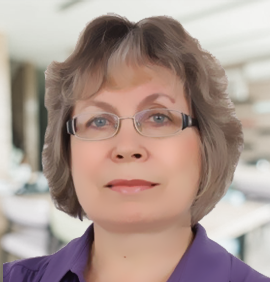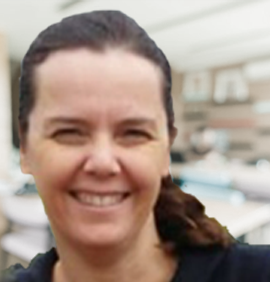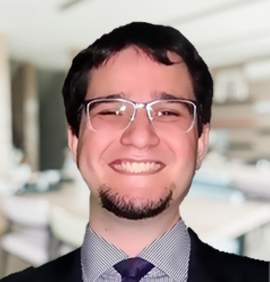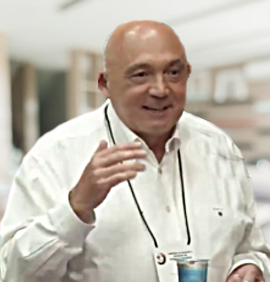 Universidade Federal de Minas Gerais
Universidade Federal de Minas GeraisElena V. Gusevskaya (Goussevskaia) possui graduação em Química pela Novosibirsk State University (Rússia) e doutorado em Cinética Química e Catálise pelo Boreskov Institute of Catalysis of the Russian Academy of Science (1981), onde atuou como pesquisadora na área de Catálise Organometálica ate 1994. Atualmente é Professora Titular do Departamento de Química da Universidade Federal de Minas Gerais. Foi membro da Câmara de Assessoramento de Ciências Exatas e dos Materiais da FAPEMIG (2000-2004) e do Comitê Assessor de Química (CA-QU) do CNPq (2011-2017). É membro correspondente do Scientific Council for Catalysis of the Russian Academy of Sciences. Tem experiência na área de Química, com ênfase em Cinética Química e Catálise, atuando principalmente nos seguintes temas: Catálise Homogênea e Heterogênea na Química Fina. Seus principais interesses atuais incluem o desenvolvimento de processos catalíticos para a valorização de substratos provenientes da biomassa, com ênfase especial na oxidação seletiva de alquenos e alcoóis, hidroformilação, hidrogenação e transformações catalisadas por ácidos.

Prof. Daniela Zanchet is an Associate Professor of the Inorganic Chemistry Department - University of Campinas, Brazil. She obtained her bachelor’s degree in Chemical Engineering from the Federal University of Paraná and master and PhD degrees in Physics from the University of Campinas. She worked as a post-doctorate fellow at the University of California, Berkeley and as a visiting researcher at the Massachusetts Institute of Technology (MIT). She also worked as a researcher at the Brazilian Synchrotron Light Technology-LNLS for more than ten years where she coordinated the initiative to developing dedicated instrumentation for in situ studies of catalysts at LNLS, supported by Petrobras. Her group focuses on the development and study of heterogeneous catalysts, based on the exploration of model nanometric systems and advanced characterization tools. She has experience in the field of nanomaterials and heterogeneous catalysts, targeting hydrogen production, CO2 and CH4 conversion and up-grading of biomass-derivatives.
Resumo da palestra: A significant share of the wordeconomy depends on process that uses catalysts and demands the development of more efficient and environmental friendly alternatives. Hydrogen is an important energy carrier and competitive and cleaner ways for its production are being sought. Catalytic reforming reactions of biomass derivatives are a natural alternative to be pursued, targeting to substitute the use of fossil fuels, such as methane, by renewable sources, such as glycerol and ethanol. Despite significant advances in understading how the catalysts work in the set of reactions involved in the hydrogen production, much has to be overcome yet to achieve rational designing from first principles. In this long pathway, the striking development of the synthesis of nanomaterials coupled to advances in in situ characterization tools at atomic level have allowed addressing important aspects in catalyst development. In this talk, model Pt-supported catalysts and modulation excitation spectroscopy are used as examples to discuss the role of different catalytic sites in the hydrogen production.
 Universidade Federal do Rio de Janeiro
Universidade Federal do Rio de JaneiroPossui experiência na área de análise química de produtos naturais e de pesticidas em alimentos por cromatografia líquida e espectrometria de massas. Obteve seu doutorado por seu trabalho com beneficiamento catalítico de etanol pela COPPE/UFRJ em 2019, com experiência na University of Virginia. Possui interesse especial por análise de dados experimentais, otimização e planejamento de experimentos, estimação de parâmetros experimentais, modelagem cinética e quanto-mecânica. Atualmente, é professor do Programa de Engenharia Química da COPPE/UFRJ e trabalha com diversos tópicos em catálise heterogênea.
 Universitat Jaume I
Universitat Jaume IProfessor Juan Andrés has been a post-doctoral researcher at Uppsala University, Sweden(1984-1990); and a Visiting professor at both Pierre et Marie Curie University, Paris (1998 and 2000) and Centro de Desenvolvimento de Materiais Funcionais (CDMF), Brazil (2007 and 2014). On returning from the postdoctoral stay at the University of Uppsala, he decided to start a project aimed at developing and applying quantum mechanics in order to understand the structure and chemical reactivity in homogeneous, heterogeneous and enzymatic catalysis. Nobody in Spain (and only few people in Europe and the US) was working on that topic, which could fit into the field of “Theoretical and Computational Chemistry” (QTC).
In 1991 Juan Andrés founded at UJI, the “Theoretical and Computational Chemistry” (QTC) Laboratory. In 2000, QTC Laboratory reached the consideration of Center of Excellence Marie-Curie within Improving Human Research Potential and the Socio-Economic Knowledge Base (Research funding of the European Union; project IHP-MCHD-99-1; 2000-2004). Several years of hard work eventually allowed us to obtain good results, which were published as scientific articles in general chemistry journals (sixteen JACS, two Chemical Society Reviews, two Angewandte Chemie, six Chemistry – A European Journal), and in prominent specific journals on physics and chemistry. These articles were the first ones addressing this area of knowledge to be published in Spain, which allowed us to achieve new projects, consolidate this line of research and generate new results. In addition to this line of research, we started working in parallel on materials science and nanotechnology, and we managed and developed R&D&I projects in collaboration with universities in Spain, Sweden, France, Chile, and Mexico, as well as a close collaboration with the CDMF in Brazil. Consequently, the productivity of the QTC grew significantly with works devoted to understanding the chemical structure and the reaction mechanism, and to reaching a deep insight of the properties, on the atomic scale, that determine the macroscopic behaviour of micro- and nanomaterials.
While being QTC’s director, more than 175 researchers and technologists from over twenty countries were trained, 30 of whom obtained a doctoral degree under its direct supervision. Today, 12 of them are Full Professors and 20 of them are Senior Lecturers at universities in Europe and South America. More than 60 of them work as researchers both at universities and R&D&I centres or hold significant positions in different industries in over 20 countries. 5 of them have set up technology-based companies.This led to the publication of numerous scientific articles in high-index international journals. Since 2005, he has published more than 280 articles in leading international journals.
The work carried out by the QTC has enabled us to produce new materials with properties that have been modulated for technological applications, such as gas sensors, photocatalysts and materials containing silver nanoparticles with very powerful bactericidal and antifungal properties, synthesised by electron and/or laser irradiation. These results have, in turn, led to the creation and consolidation of three spin-offs and start-ups.
